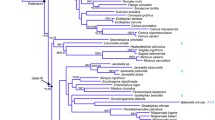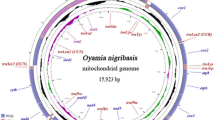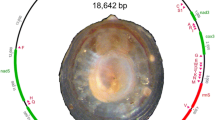Abstract
We report complete sequences of the cytochrome b, 12S rRNA, and protamine P1 genes from 18 of the 21 extant species of dasyurine marsupials (family Dasyuridae). Partial sequences are included for Pseudantechinus ningbing, but no data are available for Ps. mimulus or Phascolosorex doriae. Phylogenetic analyses of these sequences yield compatible gene trees with limited resolution. Simultaneous parsimony analysis of all three genes suggests the following: (a) a basal polytomy of eight lineages; (b) a sister-group relationship between “phascolosoricine” genera (Neophascogale and Phascolosorex, which are monophyletic) and Dasyums + Sarcophilus; (c) monophyly of Dasyurus viverrinus, D. albopunctatus, D. geoffroii, and D. spartacus apart from other quolls and Sarcophilus; and (d) sister-pairing of D. geoffroii and D. spartacus Previous attempts at unraveling the phylogenetic history of dasyurines have produced strikingly inconsistent results, due in part to differences in character systems examined, interpretations of character homology and independence, and analytical methods employed. We provide some evidence that the basal polytomy is the result of rapid cladogenesis and suggest that this episode of dasyurine evolution is temporally correlated with the onset of aridification following the New Guinean uplift of 15 million years ago.
Similar content being viewed by others
LITERATURE CITED
Aplin, K. P., Baverstock, P. R., and Donnellan, S. C. (1993). Albumin immunological evidence for the time and mode of origin of the New Guinean terrestrial mammal fauna. Sci. New Guinea 19: 131–145.
Archer, M. (1976). The dasyurid dentition and its relationship to that of didelphids, thylacinids, borhyaenids (Marsupicarnivora) and peramelids (Peramelina: Marsupialia). Aust. J. Zool. Suppl. 39: 1–34.
Archer, M. (1982). Review of the dasyurid (Marsupialia) fossil record, integration of data bearing on phylogenetic interpretation and suprageneric classification. In: Carnivorous Marsupials, M. Archer, ed., pp. 397–443, Roy. Zool. Soc. NSW, Mossman.
Archer, M. (1984a). Evolution of arid Australia and its consequences for vertebrates. In: Vertebrate Zoogeography and Evolution in Australasia, M. Archer and G. Clayton, eds., pp. 97–108, Hesperian Press, Carlisle.
Archer, M. (1984b). The Australian marsupial radiation. In: Vertebrate Zoogeography and Evolution in Australasia, M. Archer and G. Clayton, eds., pp. 633–708, Hesperian Press, Carlisle.
Archer, M., Hand, S., and Godthelp, H. (1991). Riversleigh: The Story of Animals in Ancient Rainforests of Inland Australia, Reed, Balgowlah.
Archie, J. W. (1989). A randomization test for phylogenetic information in systematic data. Syst. Zool. 38: 239–252.
Baverstock, P. R., Archer, M., Adams, M., and Richardson, B. J. (1982). Genetic relationships among 32 species of Australian dasyurid marsupials. In: Carnivorous Marsupials, M. Archer, ed., pp. 651–650, Roy. Zool. Soc. NSW, Mossman.
Baverstock, P. R., Krieg, M., and Birrell, J. (1990). Evolutionary relationships among Australian marsupials as assessed by albumin immunology. Aust. J. Zool. 37: 273–287.
Brown, W. M., Prager, E. M., Wang, A., and Wilson, A. C. (1982). Mitochondrial DNA sequences of primates: Tempo and mode of evolution. J. Mol. Evol. 18: 225–239.
Cooper, D. W., and Woolley, P. A. (1983). Confirmation of a new species of small dasyurid marsupial by electrophoretic analysis of enzymes and proteins. Aust. J. Zool. 31: 743–751.
de Queiroz, A. (1993). For consensus (sometimes). Syst. Biol. 42: 368–372.
Faith, D. P., and Cranston, P. S. (1991). Could a cladogram this short have arisen by chance alone? On permutation tests for cladistic structure. Cladistics 7: 1–28.
Felsenstein, J. (1981). Evolutionary trees from DNA sequences: A maximum likelihood approach. J. Mol. Evol. 17: 368–376.
Felsenstein, J. (1985). Confidence limits on phylogenies: An approach using the bootstrap. Evolution 39: 783–791.
Felsenstein, J. (1992). PHYLIP: Phylogeny Inference Package, Version 3.5, Department of Genetics, University of Washington, Seattle (distributed by the author).
Fitch, W. M., and Margoliash, E. (1967). Construction of phylogenetic trees. Science 155: 279–284.
Flannery, T. (1995). Mammals of New Guinea, Cornell University Press, Ithaca, NY.
Huelsenbeck, J. P., Bull, J. J., and Cunningham, C. W. (1996). Combining data in phylogenetic analysis. Trends Ecol. Evol. 11: 152–158.
Kirsch, J. A. W. (1968). Prodromus of the comparative ecology of Marsupialia. Nature 217: 418–420.
Kirsch, J. A. W., and Murray, M. D. (1969). A scheme for the identification of Australian marsupials. Aust. J. Zool. 17: 799–840.
Kirsch, J. A. W., and Springer, M. S. (1993). Timing of the molecular evolution of New Guinean marsupials. Sci. New Guinea 19: 147–156.
Kirsch, J. A. W., Krajewski, C., Springer, M. S., and Archer, M. (1990). DNA/DNA hybridization studies of carnivorous marsupials. II. Relationships among dasyurids (Marsupialia: Dasyuridae). Aust. J. Zool. 38: 673–696.
Kitchener, D. J., and Caputi, N. (1988). A new species of false antechinus (Marsupialia, Dasyuridae) from Western Australia, which remarks on the generic classification within the Parantechini. Rec. West. Aust. Mus. 14: 35–59.
Krajewski, C., Driskell, A. C., Baverstock, P. R., and Braun, M. J. (1992). Phylogenetic relationships of the thylacine (Marsupialia: Thylacinidae) among dasyuroid marsupials: Evidence from cytochrome-b DNA sequences. Proc. R. Soc. Lond. B 250: 19–27.
Krajewski, C., Painter, J., Driskell, A. C., Buckley, L., and Westerman, M. (1993). Molecular systematics of New Guinean dasyurids (Marsupialia: Dasyuridae). Sci. New Guinea 19: 157–166.
Krajewski, C., Painter, J., Buckley, L., and Westerman, M. (1994). Phylogenetic structure of the marsupial family Dasyuridae. J. Mammal. Evol. 2: 25–35.
Krajewski, C., Buckley, L., Woolley, P. A., and Westerman, M. (1996). Phylogenetic analysis of cytochrome b sequences in the dasyurid marsupial subfamily Phascogalinae: Systematics and the evolution of reproductive strategies. J. Mammal. Evol. 3: 81–91.
Krajewski, C., Blacket, M., Buckley, L., and Westerman, M. (1997a). A multigene assessment of phylogenetic relationships in the dasyurid marsupial subfamily Sminthopsinae. Mol. Phylog. Evol. 8: 236–248.
Krajewski, C., Buckley, L., and Westerman, M. (1997b). DNA phylogeny of the marsupial wolf resolved. Proc. Roy. Soc. Lond. B 26: 911–917.
Kumar, S., Tamura, K., and Nei, M. (1993). MEGA: Molecular Evolutionary Genetics Analysis, Version 1.01, Pennsylvania State University, University Park.
Lanyon, S. M. (1988). The stochastic mode of molecular evolution: what consequences for systematic investigations. Auk 105: 565–573.
Maddison, W. P. (1989). Reconstructing character evolution on polytomous cladograms. Cladistics 5: 365–377.
McGowran, B., and Li, Q. (1994). The Miocene oscillation in Southern Australia. Rec. S. Austral. Mus. 27: 197–212.
Nei, M. (1987). Molecular Evolutionary Genetics, Columbia University Press, New York.
Patton, J. L., dos Reis, S. F., and da Silva, M. N. F. (1996). Relationships among didelphid marsupials based on sequence variation in the mitochondrial cytochrome b gene. J. Mammal Evol. 3: 3–30.
Pocock, R. I. (1926). The external characters of Thylacinus, Sarcophilus, and some related marsupials. Proc. Zool. Soc. Lond. 1926: 1037–1084.
Retief, J. D., Krajewski, C., Westerman, M., and Dixon, G. H. (1995a). The evolution of protamine P1 genes in dasyurid marsupials. J. Mol. Evol. 41: 549–555.
Retief, J. D., Krajewski, C., Westerman, M., Winkfein, R. J., and Dixon, G. H. (1995b). Molecular phylogeny and evolution of marsupial protamine P1 genes. Proc. R. Soc. Lond B 259: 7–14.
Ride, W. D. L. (1964). Antechinus rosamondae, a new species of dasyurid marsupial from the Pilbara District of Western Australia, with remarks on the classification of Antechnius. West Austral. Nat. 9: 58–65.
Saitou, N., and Nei, M. (1987). The neighbor-joining method: a new method for reconstructing phylogenetic trees. Mol. Biol. Evol. 4: 406–425.
Sallis, J. D., and Guiler, E. R. (1977). Unusual plasma acid phosphatase activity in two species of Tasmanian marsupials. In: The Biology of Marsupials, B. Stonehouse and D. Gilmore, eds., pp. 327–335, Macmillan, London.
Smith, A. B. (1994). Rooting molecular trees: Problems and strategies. Biol. J. Linn. Soc. 31: 279–292.
Springer, M. S., Hollar, L. J., and Burke, A. (1995). Compensatory substitutions and the evolution of the 12S rRNA gene in mammals. Mol. Biol. Evol. 12: 1138–1150.
Springer, M. S., Kirsch, J. A. W., and Case, J. A. (1997). The chronicle of marsupial evolution. In: Molecular Evolution and Adaptive Radiation, T. J. Givnish and K. J. Sytsma, eds., pp. 129–161, Cambridge University Press, Cambridge.
Strahan, R. (1995). The Mammals of Australia, Australian Museum and Reed Books, Chatswood, NSW.
Sullivan, J., Holsinger, K. E., and Simon, C. (1995). Among-site rate variation and phylogenetic analysis of 12S rRNA in sigmodontine rodents. Mol. Biol. Ecol. 12: 988–1001.
Swofford, D. L. (1993). PAUP: Phylogenetic Analysis Using Parsimony, Version 3.1.1, Illinois Natural History Survey, Champaign, IL.
Tate, G. H. H. (1947). Results of the Archbold Expeditions. No. 56. On the anatomy and classification of the Dasyuridae. Bull. Am. Mus. Nat. Hist. 88: 101–155.
Van Dyck, S. (1987). The bronze quoll, Dasyurus spartacus (Marsupialia: Dasyuridae), a new species from the savannahs of Papua New Guinea. Aust. Mammal. 11: 145–156.
White, M. E. (1994). After the Greening: The Browning of Australia, Kangaroo Press, New South Wales.
Woolley, P. A. (1982). Phallic morphology of the Australian species of Antechinus (Dasyuridae, Marsupialia): A new taxonomic tool? In: Carnivorous Marsupials, M. Archer, ed., pp. 767–781, Roy. Zool. Soc. NSW, Mossman.
Wroe, S., and Mackness, B. S. (1997). Revision of the Pliocene dasyurid, Dasyurus? dunmalli (Dasyuridae; Marsupialia) with a review of fossil Dasyurus records. Mem. Qld. Mus. (in press).
Author information
Authors and Affiliations
Rights and permissions
About this article
Cite this article
Krajewski, C., Young, J., Buckley, L. et al. Reconstructing the Evolutionary Radiation of Dasyurine Marsupials with Cytochrome b, 12S rRNA, and Protamine P1 Gene Trees. Journal of Mammalian Evolution 4, 217–236 (1997). https://doi.org/10.1023/A:1027349725642
Issue Date:
DOI: https://doi.org/10.1023/A:1027349725642




